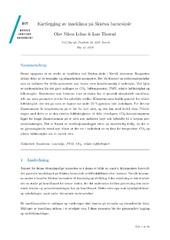| dc.contributor.advisor | Sveen, Svein-Erik | |
| dc.contributor.author | Lohne, Olav Nilsen | |
| dc.contributor.author | Thorrud, Lars | |
| dc.date.accessioned | 2019-07-02T12:34:51Z | |
| dc.date.available | 2019-07-02T12:34:51Z | |
| dc.date.issued | 2019-06-27 | |
| dc.description.abstract | The purpose of the measurements was to document whether the school had an acceptable indoor climate. An ''ørebro''-examination was performed as an indicator of which parameters might be appropriate to investigate. Using the survey, measurements of CO2, air temperature, PMV, relative humidity and airflow were made. The results that emerged showed that the school had a generally acceptable indoor climate, although some parameters deviate from the recommended values. The measurements were made with a selection of measuring instruments, where both instantaneous measurements and logging were made. The measurements were performed in two different classrooms, at two different parts of the school. These classrooms had the biggest occupancy for each part of the school, which led to these rooms being most exposed to poor indoor climate. The classrooms generally had low relative humidity. On some days the values were below 20 % throughout the school day. For one classroom, the temperature was at a slightly too low level, and it can advantageously be increased. The challenge with this is that the relative humidity will fall further. The amounts of CO2 are for both classrooms at a level that indicates an adequate rate of air exchange with respect to the occupancy. It has been found that the ventilation system is turned on unnecessarily early, as there is a consistent trend that indicates that it takes just under an hour before temperature, CO2 and relative humidity reaches a stable level. By turning on the ventilation systems at 07:00 instead of 05:00, energy savings are achieved. Although this energy saving has been found to be relatively low, there is a low-threshold measure that should be considered. No plausible reasons have been found that the measurement uncertainty weighs so heavily that the measurements should not be credible. On this basis, an overall assessment has been made. The school has an acceptable indoor climate, where there are some areas there is potential for improvement. | en_US |
| dc.identifier.uri | https://hdl.handle.net/10037/15650 | |
| dc.language.iso | nob | en_US |
| dc.publisher | UiT Norges arktiske universitet | en_US |
| dc.publisher | UiT The Arctic University of Norway | en_US |
| dc.rights.accessRights | openAccess | en_US |
| dc.rights.holder | Copyright 2019 The Author(s) | |
| dc.rights.uri | https://creativecommons.org/licenses/by-nc-sa/4.0 | en_US |
| dc.rights | Attribution-NonCommercial-ShareAlike 4.0 International (CC BY-NC-SA 4.0) | en_US |
| dc.subject.courseID | SHO6261 | |
| dc.subject | VDP::Teknologi: 500::Bygningsfag: 530 | en_US |
| dc.subject | VDP::Technology: 500::Building technology: 530 | en_US |
| dc.subject | indoor climate | en_US |
| dc.subject | school | en_US |
| dc.subject | thermal indoor climate | en_US |
| dc.subject | atmospheric indoor climate | en_US |
| dc.title | Kartlegging av inneklima på Skistua Barneskole (A study of the indoor climate at Skistua elementary school) | en_US |
| dc.type | Master thesis | en_US |
| dc.type | Mastergradsoppgave | en_US |


 English
English norsk
norsk

